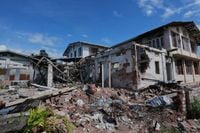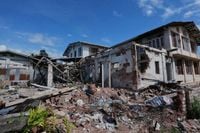Ten days after Myanmar’s military government reclaimed the battered town of Kyaukme, the silence there is deafening. Schools have reopened, but the once-vibrant market is now a shadow of its former self—most stalls are shuttered, and vendors nervously disappear at the sight of journalists. The town, nestled in Myanmar’s Shan State and once home to 46,000 people, has become a symbol of the country’s ongoing civil war, its fate tied to a strategic highway linking central Myanmar to China.
According to the Associated Press, the devastation in Kyaukme is widespread and unmistakable. Government buildings, including the courthouse, police station, and hospital, lie in ruins—charred, bombed, and abandoned. The area around the hospital was so badly damaged that medical operations had to be temporarily relocated to a nearby Chinese temple. At least one fire engine was reduced to a burnt-out shell. Yet, in a twist that speaks volumes about the nature of this conflict, most civilian homes remain standing, spared from the worst of the destruction. But that has offered little solace: the vast majority of the town’s original population has fled, leaving only a handful behind.
This rare glimpse into Kyaukme’s current state was only possible because the military allowed a single Associated Press photographer to join a tightly supervised visit, organized by pro-military Myanmar media. Independent journalists are barred from conflict zones, and the presence of foreign media is strictly controlled. As the AP journalist moved through the town, nervous vendors closed their stalls and residents spoke only on condition of anonymity, fearful of reprisals from whichever side might gain the upper hand next.
Kyaukme’s strategic significance can’t be overstated. It sits at a key junction on the main trading route to China, making it a prize for both the military government and the ethnic militias that have challenged its rule. Since the military seized power in 2021, Kyaukme has changed hands twice. In August 2024, the Ta’ang National Liberation Army (TNLA)—an ethnic Palaung militia—captured the town during a wave of victories that saw resistance forces, including ethnic minority militias and pro-democracy activists, take control of large swathes of the country. But on October 1, after a fierce three-week battle, the military retook Kyaukme, marking a significant victory as it seeks to consolidate power ahead of year-end elections.
Both sides have been quick to blame each other for the destruction. The TNLA accuses the military of launching devastating airstrikes and using heavy artillery to pound official buildings and infrastructure. The army, in turn, claims that retreating rebels intentionally destroyed key facilities to deny their use to government forces. As the AP reported, the evidence of violence is everywhere: unexploded ordnance, including a mortar shell, was found in the compound of a Buddhist monastery, and the route from the nearby town of Nawnghkio to Kyaukme is lined with buildings riddled with bullet holes or reduced to rubble.
The recapture of Kyaukme is just the latest move in a broader campaign by the military to reassert control over contested territories. In July 2025, the army retook Nawnghkio, a town that sits at the crossroads of Myanmar’s eastern hills and central flatlands—another strategic location on the road to Kyaukme. Along the 55-kilometer stretch between the two towns, journalists observed frequent army checkpoints, manned by newly drafted soldiers every 500 to 1,000 meters. A major bridge on the route was damaged in the fighting but remains standing, now under repair.
Despite the military’s efforts to project an image of normalcy—reopening schools and allowing limited media access—the reality on the ground is far from stable. The TNLA is believed to be just 32 kilometers away, entrenched in the hills and ready to contest any further government advances. Land mines and unexploded ordnance remain a constant threat; authorities warned journalists away from certain neighborhoods, citing the danger. "There are still land mines that haven't been cleared in parts of the neighbourhood," Capt. Wai Yan Kyaw, stationed at one of the town’s gates, told the AP.
The psychological scars of war are evident in the reluctance of residents to return. A local who stayed behind during the fighting explained, under condition of anonymity, that most people fled when the battle erupted last year. Those who remained did so largely because they couldn’t afford to leave. Even now, few are willing to return while the front lines remain so close. As a motorbike taxi driver, who also requested anonymity, put it, "People are unwilling to live near the front line." He added that a genuine recovery is unlikely until the army regains control of more surrounding towns, pushing the conflict further from Kyaukme’s doorstep.
The military’s recent string of offensives appears to be part of a broader strategy to shore up its authority before the scheduled elections at the end of the year. However, critics argue that these elections are little more than a facade. With most of the country still gripped by violence and the opposition largely excluded from the process, few expect the polls to be free or fair. Still, the army is banking on a high turnout to lend legitimacy to the results.
Meanwhile, the cost to ordinary people is staggering. Kyaukme, once a bustling hub and a vital link in Myanmar’s trade with China, now stands as a ghost town. The few who have returned move cautiously through streets haunted by the memory of violence. Many shops remain shuttered, and the market—once the lifeblood of the community—is a pale imitation of its former self. The fear of renewed fighting, the ever-present risk of land mines, and the proximity to active front lines all combine to keep the population at bay.
For now, Kyaukme’s fate hangs in the balance. The town’s recovery, locals say, depends entirely on whether the military can secure the surrounding areas and push the conflict further away. Until then, the silence that has settled over Kyaukme serves as a stark reminder of the unresolved conflict tearing Myanmar apart—and the heavy price paid by those caught in the crossfire.


